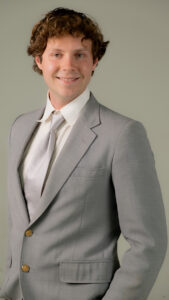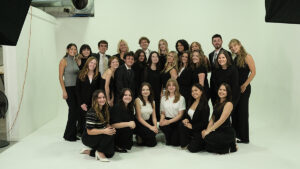By Alex Truex
When you sit down with this year’s Arrowhead Captain, one thing becomes clear right away: storytelling is at the heart of everything he does—whether it’s through film, leadership, or strategy. From creating brand anthems for AT&T and Tide to directing shoots in canyons and classrooms, his journey has been about blending creativity with purpose.
 What made you want to join Arrowhead in the first place?
What made you want to join Arrowhead in the first place?
I first heard about Arrowhead in my Principles of Advertising class. The team came in and explained what Arrowhead was, and we got the chance to develop a creative strategy and campaign around it. That experience sparked something for me. I already had a background in video production and loved the collaborative element of building something as a team. What really hooked me was the science behind the strategy—taking research and turning it into a creative idea.
Later, I showed some of my short films to Dr. Kelly, and she encouraged me to apply for the video team. By spring 2023, I was working on Tide’s campaign and helping develop the brand anthem. That project gave me a real taste of Arrowhead’s scale and potential.
What was your role on Arrowhead last year, and what did you take away from that experience?
Last year, I worked as a director on the video team. I got to dig into research insights and figure out how to tell a story that matched the strategy. One big takeaway was the importance of assigning roles clearly. On Tide, we learned howcrucial it was to define responsibilities. When it came time for the AT&T campaign, I carried that forward—making sureevery person had a clear role, which made the production smoother and more collaborative.
How has your experience been as Captain so far? What’s surprised you most?
It’s been exciting. I spent a lot of time over the summer figuring out the team’s structure—what worked in past years,what didn’t, and who was best suited for what roles. The biggest surprise?
Learning to slow down. I naturally want to jump in and get things done fast, but faculty pushed me to take a step back. Good things take time, and that mindset has made the process more thoughtful and productive.
What does it mean to you personally to be Captain of Arrowhead?
There are big shoes to fill. Leaders like Leah Solomon, Max Mitchell, and Kassidy Saba all did incredible work before me. For me, being captain means serving the people on the team—building schedules, setting goals, and creating strategies that allow everyone to do their best work. My job is to put people in the right position so they can shine.

What’s your vision for Arrowhead this year?
Our structure is ambitious. Right now, we’re focused on primary research—getting out into the field and capturing theinsights we need. From there, we’ll build strategy differently than in past years and then move into developing a creative campaign in the spring. Come April, we’ll be ready to present something the whole team is proud of.
What was it like directing large-scale projects for brands like AT&T and Tide?
The Tide campaign was a turning point. We had a strong team, but at first roles weren’t clearly defined, which causedsome confusion. That experience taught me how essential clarity is. By the time we worked on AT&T, everyone had a specific responsibility, and communication flowed. It showed me that great creative work happens when everyone knows their part.
How do you blend research and strategy into your creative work?
It always starts with the audience. Who are we talking to, and what do we want them to take away? Research tells uswhat they respond to—like music preferences or humor styles—and then we shape the story around that. For AT&T, research showed the target audience liked fast-paced, funny content. So we leaned into quick cuts and energetic edits to keep their attention.
Tell us about your internship at WFSU Public Media. Any projects you’re especially proud of?
Working at WFSU has been a great experience. One project I’m most proud of was documenting community outreach for PBS. We created educational activities based on characters like Lyla in the Loop and brought them into classrooms. My role was to capture the impact—how kids were engaging, what they were learning, and why it mattered. It pushed me to think about brand consistency too—adapting my style to fit WFSU’s look while still telling a compelling story.
What about your time with Strike Magazine? Any memorable shoots?
I love the ones that take us to unique locations. Shooting at Providence Canyon in Georgia was a favorite, and another time we shot on the beach. But one of the most memorable was an extraterrestrial-themed shoot featuring a trans model. We used grey tones and a warehouse setting in Tallahassee to highlight the feeling of alienation, then flipped it into something empowering through fashion. That’s what I love about Strike—using style as a storytelling platform.
You’ve been an independent filmmaker since 2019. What have you learned about yourself?
My independent work taught me how to manage groups and find my voice as a storyteller. I’ve tackled projects around mental health, self-esteem, and other personal themes. Those experiences helped me discover what kinds of stories resonate with me and how I want to tell them.
What’s been your most challenging project, and how has working across different settings shaped your leadership?
Scaling up projects has been challenging. Early on, we’d film across six locations without clearing permissions, and it was stressful just hoping we wouldn’t get kicked out. Now I’ve learned to pace myself and focus on logistics—clearances, timing, and planning.
Across Arrowhead, WFSU, Strike, and independent film, I’ve learned that leadership is about creating an environment where people want to do their best work. If you can motivate a team and give them space to thrive, that’s half the job.
What advice would you give to someone thinking about joining Arrowhead?
Find your secret sauce. Figure out what you bring to the table that sets you apart—whether that’s video, design, writing, or something else. Then show it off. Create mockups, put together sample campaigns, and prove you can do the work. That initiative makes a huge difference.
What’s next for you?
I’m working on my Honors in the Major thesis—a 35-page project and proof of concept for a potential show. My goal isto combine it with market research, so I know where and how to pitch it. Beyond that, I’ve got a lot of paths I could take—whether that’s agencies or independent projects. For now, I’m focused on taking advantage of all the opportunities FSU offers.
I’m super excited about this year. We have an insanely talented team and a really cool brand we’re working with. We’re ready to build a campaign that everyone can be proud of.
–
Alex Truex, an advertising major at FSU’s School of Communication and president of the Ad Club, a registered student organization, wrote and edited this article for the team’s blog.
